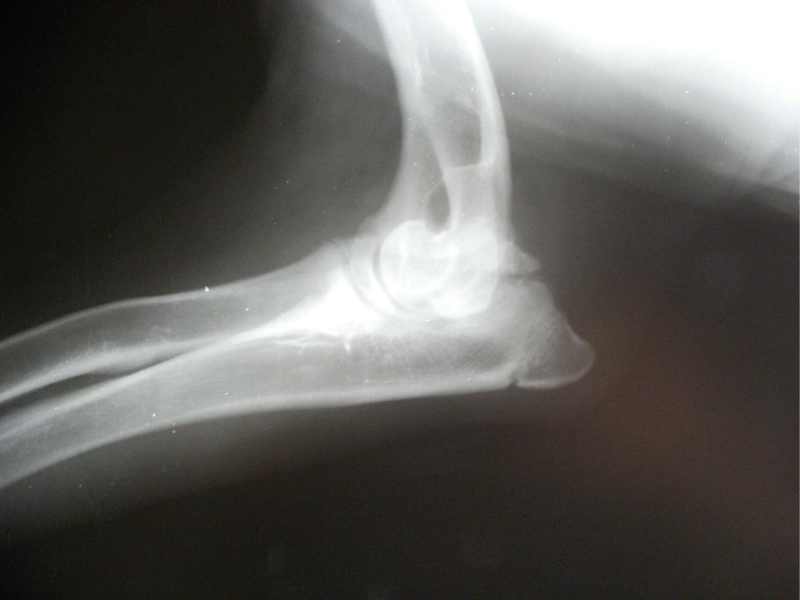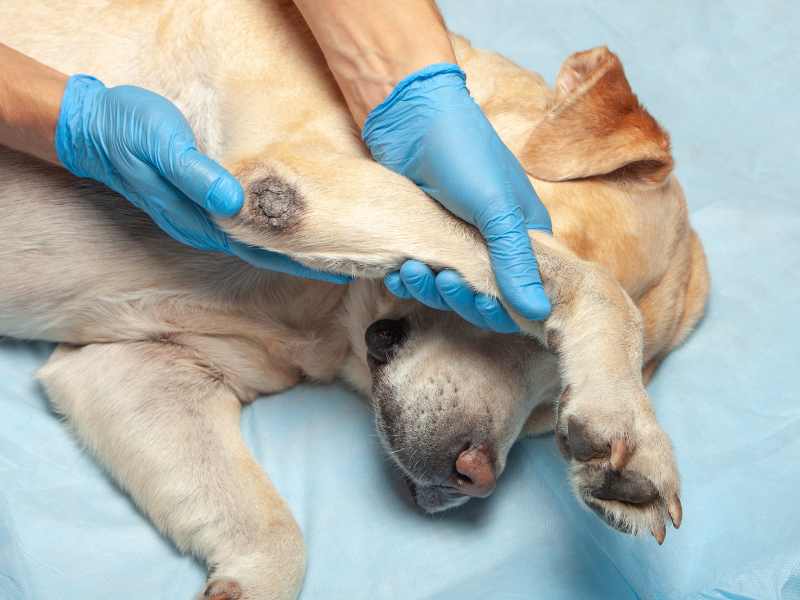What Is Canine Elbow Dysplasia In Dogs?
Canine elbow dysplasia is a bit like a bad hinge on a door—it makes movement awkward and can worsen with time if not properly addressed. This condition affects the elbow joint and is most commonly seen in larger dog breeds, though no dog is immune. It’s characterized by a developmental anomaly that causes the elbow components to grow unevenly, leading to pain, lameness, and potentially, a significant reduction in quality of life.
Canine Elbow Dysplasia: A Closer Look at the Canine Elbow Joint

The elbow joint in dogs is a complex system involving three bones: the humerus (upper arm), the radius, and the ulna (both in the forearm). In a healthy dog, these bones slide and rotate smoothly against each other, cushioned by cartilage that prevents them from rubbing directly. Ligaments and tendons support and stabilize the joint. When a dog has elbow dysplasia, this harmony is disrupted, leading to friction, inflammation, and pain as the bones and cartilage grind improperly. Canine elbow dysplasia is a condition group that is made of four developmental abnormalities that include:
- Ununited Anconeal Process (UAP): In some dogs, especially as they grow, a small bone in their elbow doesn’t fuse with the main bone it’s supposed to. This can cause the joint to become unstable and painful.
- Fragmented Coronoid Process (FCP): This is like a tiny crack in one of the elbow bone’s supporting points, which then breaks into a small piece. This loose piece can irritate the elbow whenever the dog moves it, leading to discomfort.
- Osteochondrosis of the Humeral Condyle: In the elbow joint, there’s a layer of cartilage that’s supposed to be smoothly attached to the end of the upper arm bone. When a part of this layer breaks away, it can cause pain because it disrupts the joint’s smooth movement.
- Joint Incongruity: The elbow works smoothly when all the parts fit together just right. If they don’t, like a puzzle with forced pieces, the joint can suffer from uneven pressure and wear, which isn’t good for the dog’s mobility and can be pretty painful.
Symptoms of Canine Elbow Dysplasia
Elbow dysplasia can begin to appear slowly and subtly, but even these early signs are significant red flags if you know what to look for. Common initial symptoms include:
- Limping or Lameness: This is often one of the first signs that there may be an issue with a dog’s elbow. It might be more noticeable after your dog has been resting and then gets up to move.
- Pain: If your dog shows signs of discomfort when their elbow area is touched or if they shy away from normal contact in that region, it could be a sign of pain associated with the condition.
- Reluctance to Play or Exercise: Dogs suffering from joint pain might be less eager to engage in play or may appear lethargic when asked to exercise. This could also present as difficulty in performing previously easy activities, like climbing stairs or jumping.
Progression of Symptoms Without Intervention
Without appropriate treatment, the symptoms of elbow dysplasia can progress, leading to more severe and chronic issues such as:
- Increased Stiffness: As the condition worsens, the dog may show increased stiffness in the joints, particularly after lying down for extended periods.
- Decreased Range of Motion: Over time, the affected joint may lose its flexibility, making it harder for the dog to use the limb normally, which can affect the way they walk and run.
- Development of Arthritis: Chronic joint instability and damage can lead to secondary osteoarthritis, characterized by further joint pain, swelling, and reduced mobility.
- Muscle Atrophy: Due to reduced activity and joint function, muscle wastage around the affected limb can occur, compounding the difficulties with movement.
Which Dogs Are Most At Risk For Canine Elbow Dysplasia?
Elbow dysplasia commonly affects larger breeds, because they put more stress on their joints due to their size and weight. Breeds particularly prone to this condition include Labrador Retrievers, Golden Retrievers, German Shepherds, and Rottweilers. However, don’t be fooled into thinking smaller breeds are exempt; they can also develop elbow dysplasia, especially if they have genetic predispositions or if they suffer from poor nutrition and improper exercise during their growth phases in puppyhood.
Causes and Risk Factors of Canine Elbow Dysplasia
Genetic Predisposition and Hereditary Aspects
Canine elbow dysplasia is heavily influenced by genetic factors, which makes it a significant concern for breeders and owners of predisposed breeds. Studies have highlighted that the condition is heritable, meaning it can be passed from parents to offspring through genes. Research using advanced genetic modeling and whole-genome sequencing has identified specific genomic regions associated with the phenotypic variation of traits like elbow dysplasia across different dog breeds. This suggests that selective breeding practices, focusing on these genetic markers, could help reduce the condition’s prevalence over time.
Environmental and Developmental Factors
Besides genetics, environmental and developmental factors also play a crucial role in the onset and progression of elbow dysplasia. Rapid growth periods, particularly in large-breed puppies, can exacerbate the risk without adequate nutrition and physical activity. Overfeeding, leading to rapid weight gain, has been shown to contribute to the development of joint disorders, including elbow dysplasia. Consistent and moderate exercise can support joint health and prevent excessive stress on the developing elbow joint.
Diagnosis of Elbow Dysplasia In Dogs
Diagnosing elbow dysplasia accurately is so important for effective management and treatment. Veterinarians rely on several tools and techniques to diagnose this condition:
- X-rays: These are the most common diagnostic tools used to assess bone structure and joint integrity. X-rays can reveal changes in the elbow joint, such as bone spurs, joint space narrowing, and signs of arthritis that often accompany elbow dysplasia.
- Computed Tomography (CT) Scans: CT scans provide a more detailed view of the elbow joint than standard X-rays. They can help assess the severity of the dysplasia and are particularly useful in identifying specific anatomical abnormalities associated with the condition, such as fragmented coronoid or ununited anconeal processes.
- Magnetic Resonance Imaging (MRI): MRI is less commonly used but can be valuable in evaluating the soft tissues around the joint, including cartilage and tendons, which are not well visualized on X-rays or CT scans.
Treatment Options for Canine Elbow Dysplasia
Non-surgical approaches to managing elbow dysplasia focus on alleviating pain and maintaining joint function. Common non-surgical treatments include:
- Physical Therapy: Techniques like massage, passive range of motion exercises, and hydrotherapy can help maintain joint mobility and muscle strength
- Weight Management: Keeping your dog at a healthy weight reduces stress on the joints, which is crucial for dogs with elbow dysplasia.
- Medications: Non-steroidal anti-inflammatory drugs (NSAIDs) are commonly prescribed to control pain and inflammation. Other options may include pharmacological supplements or injections like platelet-rich plasma (PRP), hyaluronic acid, or stem cells to help manage symptoms and potentially improve joint health.
- Natural Supplementation: Dog parents are turning more to natural supplementation to work with their dog’s own body chemistry and more natural, holistic options for pain and overall mobility and joint health.
Surgical Treatments For Canine Elbow Dysplasia When non-surgical treatments are not working, surgical options may be considered, especially in more severe cases:
- Arthroscopy: This minimally invasive surgery involves inserting a small camera into the joint to remove bone and cartilage fragments, or to clean up the joint space. This can help reduce pain and improve function.
- Osteotomy: Procedures such as the sliding humeral osteotomy or proximal ulna osteotomy are performed to correct bone deformities and improve joint alignment.
- Fragment Removal: In cases like fragmented medial coronoid process (FCP), arthroscopic techniques are used to remove the fragmented pieces, which can alleviate irritation in the joint.
The overall prognosis for dogs with elbow dysplasia depends on the severity of the condition, the age at which treatment is started, and the chosen treatment method. Most dogs can lead a reasonably normal life with appropriate management, but progressive arthritis often becomes a diagnosis. A focus on joint and mobility health from the earliest onset can also significantly improve outcomes and pain levels.
Managing Care For A Dog With Elbow Dysplasia

When managing elbow dysplasia in dogs, lifestyle changes can significantly improve your pet’s quality of life. A focus on mobility and joint health is key, and incorporating ingredients that science shows to be effective can make a world of difference.
- Supplementation: Nutritional supplements containing anti-inflammatories, antioxidants, proteins, collagens, and omega-3 fatty acids can be beneficial. These include ingredients such as green-lipped mussels, turmeric/curcumin, and omega-3s from sources like flaxseed oil, anchovy oil, or algal oil.
- Exercise Modification: Regular, gentle exercise can help maintain joint mobility and muscle mass. However, avoid activities that strain the joints excessively, like jumping or running on hard surfaces.
- Weight Control: Maintaining an ideal body weight to minimize stress on the joints is crucial. This may involve a special diet and portion control.
Potential Long-Term Management Strategies
- Physical Rehabilitation: Professional rehabilitation therapies, such as hydrotherapy or targeted physical therapy, can significantly enhance your dog’s mobility and strength.
- Home Environment Adjustments: Making your home more comfortable for a dog with joint issues is helpful. Use ramps instead of stairs, provide orthopedic bedding, and keep essential items within easy reach.
Remember, each dog with elbow dysplasia will have unique needs. It’s about creating a tailored plan that includes effective and research-based dietary supplements, appropriate exercise, weight management, and veterinary support to ensure a good quality of life. That’s what we had in mind when we created Bernie’s Marvelous Mobility. We wanted our own large breed best friend to have as pain-free and happy of a life as he could. We don’t use the popular glucosamine or chondroitin because the science simply doesn’t show the efficacy that other ingredients like Undenatured Type-II C Collagen or green-lipped mussel or turmeric do when it comes to helping reduce pain and inflammation. We only want the best, cleanest, and most effective mobility support for our dogs, and want that for your dog too.





